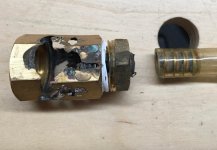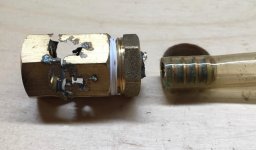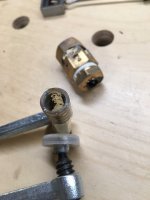Cheese
Member
- Joined
- Jan 16, 2015
- Messages
- 12,503
About 6 years ago I installed a Rinnai condensing, tankless water heater rated at 97% efficiency. It came with a condensate trap and a connection for a condensate drain.
When I originally plumbed the condensate drain I used a brass union along with a brass barbed fitting attached to a short section of PVC hose. That went to a condensate pump.
Yesterday I noticed some water on the floor underneath the Rinnai and decided to investigate. Here's what I found.
The brass coupling and the brass barbed fitting.
[attachimg=1]
[attachimg=2]
In this photo you can see that one section/side of the barbed fitting is completely dissolved.
[attachimg=3]
Here's a good article if you're interested in more info. [smile]
https://www.canada.ca/en/conservati...on-institute-notes/dezincification-brass.html
When I originally plumbed the condensate drain I used a brass union along with a brass barbed fitting attached to a short section of PVC hose. That went to a condensate pump.
Yesterday I noticed some water on the floor underneath the Rinnai and decided to investigate. Here's what I found.
The brass coupling and the brass barbed fitting.
[attachimg=1]
[attachimg=2]
In this photo you can see that one section/side of the barbed fitting is completely dissolved.
[attachimg=3]
Here's a good article if you're interested in more info. [smile]
https://www.canada.ca/en/conservati...on-institute-notes/dezincification-brass.html



